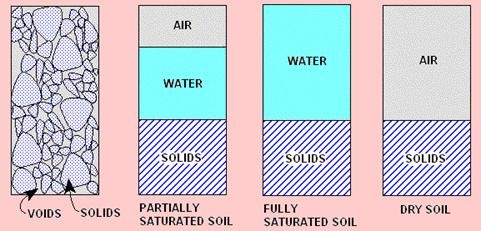Ever notice cracking in a building facade, or a door sticking in the frame? Or an uneven slab or damage to utilities entering a structure or equipment? Often the guilty culprit is consolidation settlement of the soils supporting the foundation. Realizing the potential for soil consolidation at a site during the design phase of a project can mitigate costly future issues associated with total and differential settlement of a foundation system.
Soil Matrix
To understand soil consolidation, first we need to recognize the make-up of the soil matrix undergoing volume change. As shown in the figure below, soil is made up of solid particles and voids (space between the solid particles). The soil can be in one of three states: 1) Partially Saturated; 2) Fully Saturated; or 3) Dry.

Consolidation vs Compaction
如果我们假设固体土壤颗粒不deform, then densification of a volume of soil can occur only with expulsion of air or water from the soil matrix. The expulsion of air from a soil matrix due to an applied stress (load) is considered Compaction. The expulsion of water from a soil matrix due to an applied stress is considered Consolidation. Since air can normally move freely from the void space in a soil matrix, compaction can be achieved in a relatively short timeframe. Consolidation, however, takes a longer period as explained in the next paragraph.
Consolidation
Consolidation occurs when stress is applied to a soil that causes densification (settlement) due to water being displaced from between the soil grains. Since consolidation is the displacement of water within a soil matrix, free-draining granular soils (sands and gravels) densify immediately upon applying a stress to the soil. However, cohesive soils (clays) develop excess pore pressure within the void space when stress is applied, requiring long periods of time to fully densify, or settle. This period can be months or years, as the excess pore pressures must dissipate for consolidation to occur.
Estimating Settlement
To predict the total amount of settlement beneath a foundation, approximations of the applied stresses and resulting consolidation are made using results from laboratory tests conducted on samples of the supporting soil and computer programs that model the stress distributions.
Laboratory Testing. Soil samples collected from a geotechnical investigation are tested in a laboratory using an oedometer that measures the soil consolidation properties of the material. Oedometer tests are performed by applying different loads to soils samples and measuring the deformation response to each load. Of particular importance to the quantity of settlement that will be experienced by a soil layer is thePreconsolidation Pressure, or the effective stress a soil has experienced at some point in the past. When applying foundation loads to the soil subgrade, load intensities that are less than the preconsolidation pressure typically experience less settlement than load intensities that exceed the preconsolidation pressure. Laboratory testing helps estimate the Recompression Index (Cr) that defines the change in soil volume (settlement) for loads less than the preconsolidation pressure. The Oedometer test also estimates theCompression Index (Cc)that defines the settlement under loads that are greater than the preconsolidation pressure.
Applied Stress. The information provided by the foundation designer is equally important to the information the geotechnical engineer develops for the compressibility parameters of the soil. Without accurate information on the foundation size, geometry, and anticipated sustained load intensity across the entire foundation bearing surface, estimates of settlement cannot be precise. Additionally, external influences such as nearby structures, planned site grade raises and dewatering efforts can dramatically affect the rate of settlement and/or the total magnitude of settlement that will be experienced by your foundation.
Calculating Settlement. Computer programs are available to estimate the settlement under foundations, embankments and other surface loads that increase vertical stress in the soil subgrade. These software allow the user to define the stratigraphy and compressibility characteristics of the soil beneath a foundation or combination of surface loading conditions. The geometry and load intensities can be modelled for single or multiple foundation scenarios, and values of settlement are estimated at discreet locations below each foundation. These software are also capable of estimating time-rate of settlement and calculating pore pressure dissipation for modelling wick drains and other settlement acceleration techniques.
Our Capabilities
Braun Intertec Corporation has a team of Professional Engineers with experience in designing foundations within areas where highly compressible soils are present. These include near waterways and shoreline regions where alluvial deposits exist. Our certified laboratories provide our engineers with quality results to evaluate consolidation. Experience and communication with our Clients allow for realistic modelling of their foundation systems and loading conditions. Together, we can make realistic predictions of settlement to assist during the design phase of your projects, so that costly repairs and loss of use do not occur during the operational life of your foundation.
